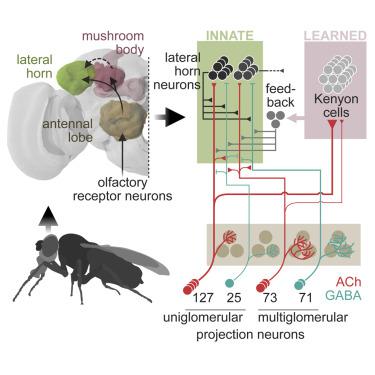Current Biology ( IF 8.1 ) Pub Date : 2020-07-02 , DOI: 10.1016/j.cub.2020.06.042 Alexander S Bates 1 , Philipp Schlegel 2 , Ruairi J V Roberts 3 , Nikolas Drummond 3 , Imaan F M Tamimi 3 , Robert Turnbull 3 , Xincheng Zhao 4 , Elizabeth C Marin 3 , Patricia D Popovici 1 , Serene Dhawan 3 , Arian Jamasb 3 , Alexandre Javier 3 , Laia Serratosa Capdevila 3 , Feng Li 5 , Gerald M Rubin 5 , Scott Waddell 6 , Davi D Bock 7 , Marta Costa 3 , Gregory S X E Jefferis 2

|
Nervous systems contain sensory neurons, local neurons, projection neurons, and motor neurons. To understand how these building blocks form whole circuits, we must distil these broad classes into neuronal cell types and describe their network connectivity. Using an electron micrograph dataset for an entire Drosophila melanogaster brain, we reconstruct the first complete inventory of olfactory projections connecting the antennal lobe, the insect analog of the mammalian olfactory bulb, to higher-order brain regions in an adult animal brain. We then connect this inventory to extant data in the literature, providing synaptic-resolution “holotypes” both for heavily investigated and previously unknown cell types. Projection neurons are approximately twice as numerous as reported by light level studies; cell types are stereotyped, but not identical, in cell and synapse numbers between brain hemispheres. The lateral horn, the insect analog of the mammalian cortical amygdala, is the main target for this olfactory information and has been shown to guide innate behavior. Here, we find new connectivity motifs, including axo-axonic connectivity between projection neurons, feedback, and lateral inhibition of these axons by a large population of neurons, and the convergence of different inputs, including non-olfactory inputs and memory-related feedback onto third-order olfactory neurons. These features are less prominent in the mushroom body calyx, the insect analog of the mammalian piriform cortex and a center for associative memory. Our work provides a complete neuroanatomical platform for future studies of the adult Drosophila olfactory system.
中文翻译:

果蝇大脑中嗅觉投射神经元的完整连接组重建。
神经系统包含感觉神经元、局部神经元、投射神经元和运动神经元。为了理解这些构建块如何形成整个电路,我们必须将这些广泛的类别提炼为神经元细胞类型并描述它们的网络连接性。使用整个果蝇大脑的电子显微照片数据集,我们重建了第一个完整的嗅觉投射清单,将触角叶(哺乳动物嗅球的昆虫类似物)与成年动物大脑中的高阶大脑区域连接起来。然后,我们将这个清单与文献中的现有数据联系起来,为经过深入研究的细胞类型和以前未知的细胞类型提供突触分辨率“正模型”。投射神经元的数量大约是光水平研究报告的两倍;大脑半球之间的细胞类型和突触数量是固定的,但并不完全相同。侧角是哺乳动物皮质杏仁核的昆虫类似物,是这种嗅觉信息的主要目标,并已被证明可以引导先天行为。在这里,我们发现了新的连接基序,包括投射神经元之间的轴突连接、反馈和大量神经元对这些轴突的横向抑制,以及不同输入的收敛,包括非嗅觉输入和记忆相关的反馈三级嗅觉神经元。这些特征在蘑菇体花萼中不太突出,蘑菇体花萼是哺乳动物梨状皮层的昆虫类似物,也是联想记忆的中心。我们的工作为成年果蝇嗅觉系统的未来研究提供了完整的神经解剖学平台。











































 京公网安备 11010802027423号
京公网安备 11010802027423号